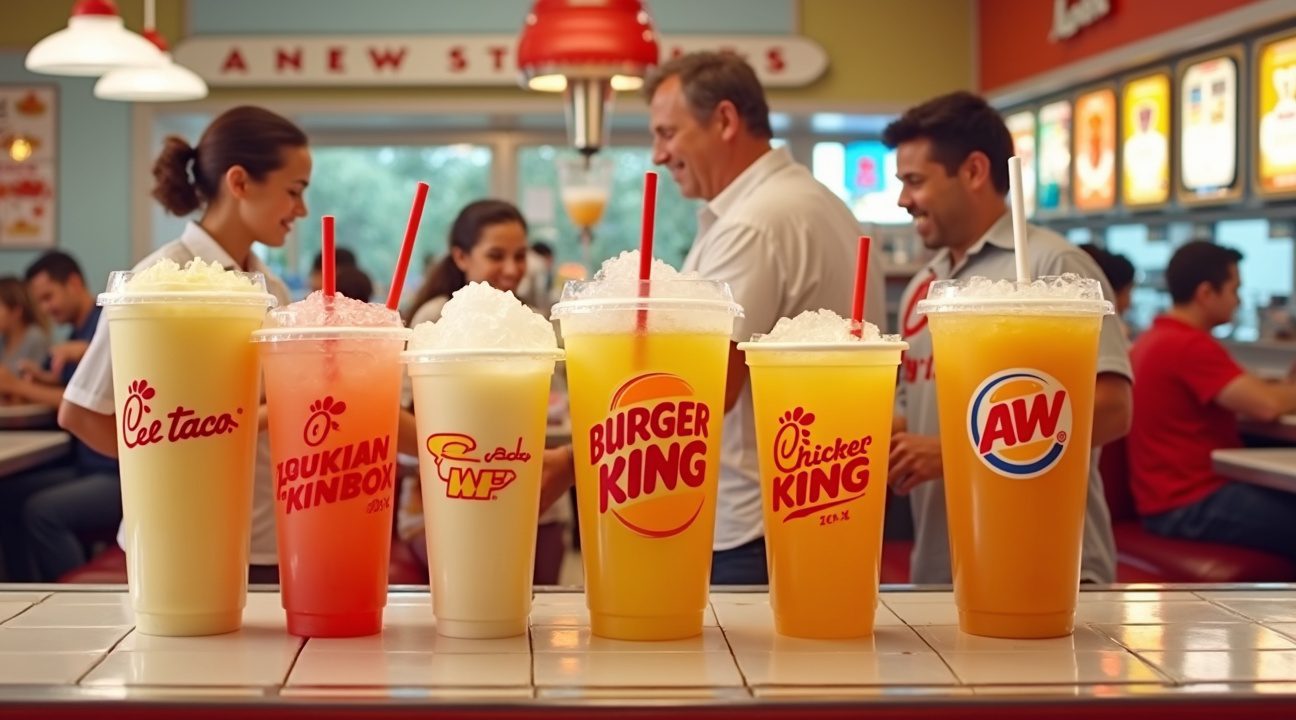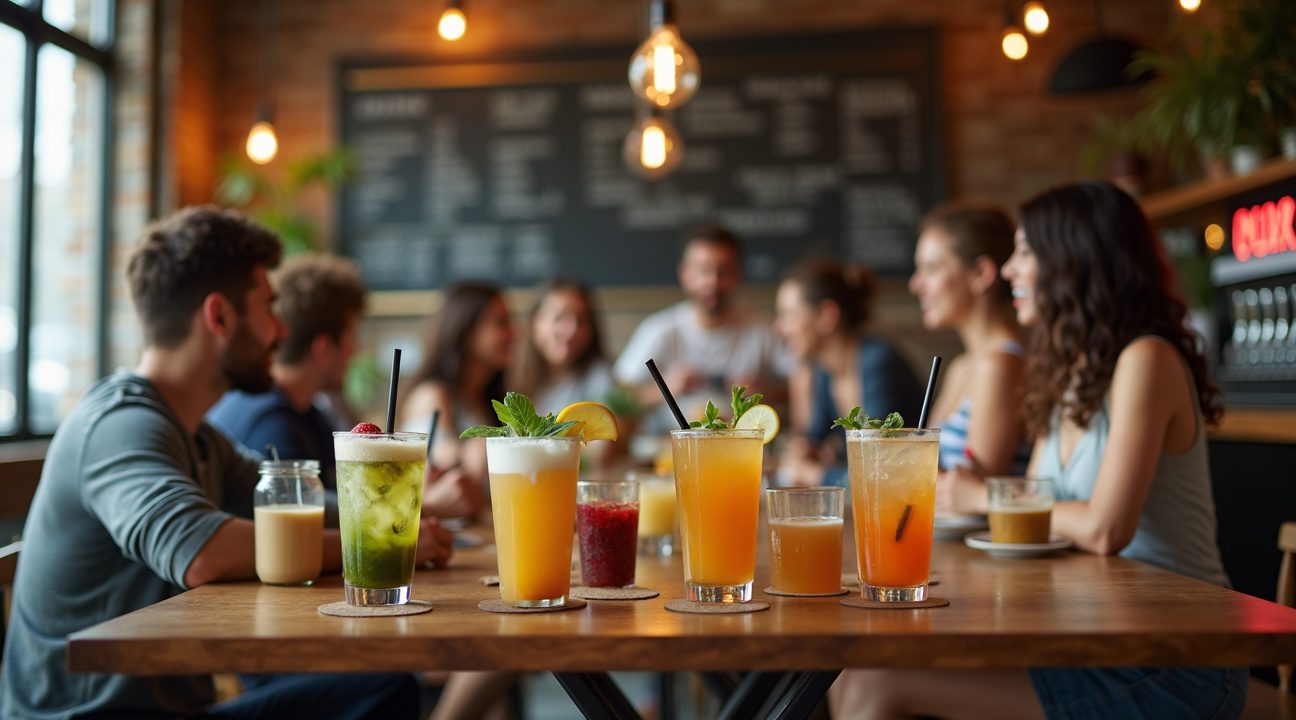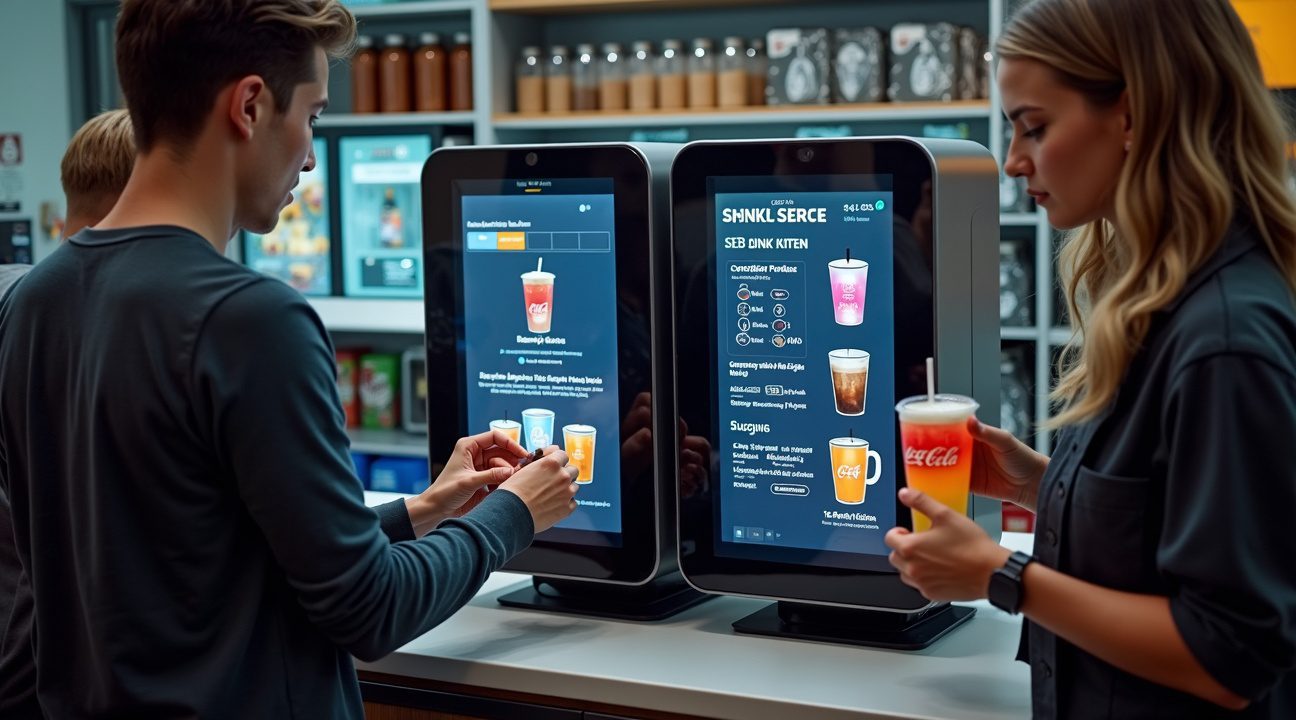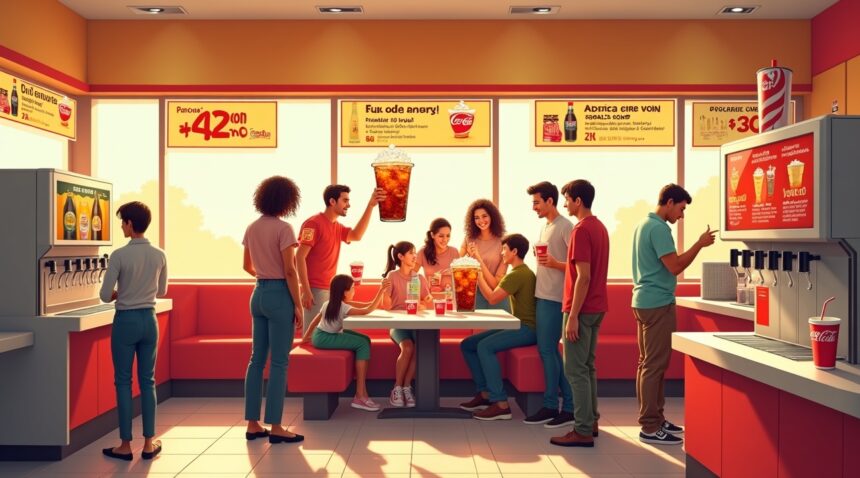Several fast-food establishments continue to serve supersized fountain beverages despite industry-wide trends moving away from massive drink portions.
Del Taco and Jack in the Box stand out as leaders in this space, offering impressive 40-ounce fountain drinks that deliver the classic Coca-Cola experience customers crave. The soda fountain machine market, valued at $1.1 billion, continues to grow as restaurants adopt advanced dispensing technology to preserve that distinctive, traditional taste.
Key Takeaways
- Del Taco and Jack in the Box offer the largest fountain drinks at 40 ounces, with Burger King close behind at 38 ounces. Most other chains have capped sizes between 30-32 ounces.
- The global soda fountain machine market hit $1.1 billion in 2025 and is projected to grow annually by 5.7% due to innovations and restaurants’ focus on authentic beverage experiences.
- Market share for traditional carbonated soft drinks has fallen from 46% to 41% as younger consumers opt for specialty beverages like iced tea and craft coffee.
- Fountain drinks remain highly profitable with 51.76% gross margins and 9.6% year-over-year growth, reinforcing their importance as key revenue drivers.
- Convenience stores are leading innovation by introducing digital beverage systems that let customers fine-tune carbonation and syrup levels for a custom fountain drink experience.
When Fast Food Giants Served Half-Gallon Sodas: The Era of Supersized Drinks is Over
I remember a time when fast food restaurants competed fiercely to offer the largest possible drink sizes, creating an arms race of beverage portions that seems almost unthinkable today. The era of supersized sodas has completely vanished from mainstream chains, marking a significant shift in how restaurants approach their fountain drink offerings.
The Giants That Once Ruled Portion Sizes
McDonald’s famously led the charge with their “Supersize” option, which included a massive 42-ounce fountain drink that dwarfed today’s large sizes. This option disappeared entirely when the company discontinued the Supersize program, never to return despite nostalgic customer requests. The golden arches made this decision permanent, recognizing changing consumer attitudes about health and portion control.
KFC took supersizing to an even more extreme level with their “Beverage Bucket,” a staggering 64-ounce soda option that literally constituted a half-gallon of fountain drink. This enormous serving has been completely eliminated from their menu, with the chain’s current maximum size capping at just 30 ounces as of August 2025. The contrast between then and now couldn’t be more stark — customers once received more than double today’s largest serving.
Dairy Queen also participated in this supersizing trend by offering a 46-ounce reusable soda mug that customers could refill during visits. This oversized option has since disappeared from their menu boards, replaced by more conventional sizing standards that align with current industry practices.
The Industry’s Complete Transformation
This dramatic reduction in maximum drink sizes reflects a broader industry trend driven by increasing health consciousness among consumers. Restaurants have fundamentally shifted their approach, recognizing that offering extremely large portions can create negative publicity and potential liability concerns. The change represents more than just menu adjustments — it signals a complete philosophical shift in how chains position themselves in the marketplace.
Historical context reveals just how dramatically restaurant beverage offerings have changed over the past two decades. Where chains once competed on who could offer the largest drink, they now focus on
- quality,
- variety,
- and reasonable portion sizes.
This transformation mirrors broader societal changes regarding nutrition awareness and personal responsibility.
Fast food executives discovered that customers weren’t necessarily demanding these enormous sizes — they were simply ordering them because they represented perceived value. Many patrons couldn’t actually finish these massive drinks, leading to waste and buyer’s remorse. Chains realized they could maintain customer satisfaction while offering more reasonable portions that didn’t contribute to negative health headlines.
The disappearance of half-gallon sodas also coincided with increased regulatory scrutiny regarding portion sizes and marketing practices. Some municipalities began considering restrictions on large drink sizes, prompting proactive changes from major chains. Rather than fight regulations, most companies chose to voluntarily reduce their maximum offerings.
Modern fountain drink programs now emphasize customization and quality over sheer volume. Chains invest in better syrup ratios, ice quality, and flavor variety rather than competing on who can serve the most liquid per cup. This approach has proven more sustainable both financially and from a public relations standpoint.
The era when customers could walk into a fast food restaurant and order what amounted to a half-gallon of soda has definitively ended. Today’s largest fountain drinks typically max out around 30–32 ounces across major chains, representing a complete reversal from the supersizing philosophy that once dominated the industry. This shift demonstrates how quickly and thoroughly restaurant culture can evolve when consumer preferences and health awareness reach a tipping point.
Where You Can Still Find the Biggest Fountain Drinks Today
Fast-food chains continue to compete for customers seeking the ultimate fountain drink experience, with several establishments offering impressively large serving sizes that rival the generous portions of decades past. Del Taco leads the pack with its massive 40-ounce fountain drink option, positioning itself as a top destination for those who want maximum refreshment value. Jack in the Box matches this offering with its “Jumbo” drink size, also clocking in at a substantial 40 ounces.
Burger King takes a slightly different approach, providing customers with a 38-ounce fountain drink that pairs perfectly with their signature Whopper sandwich. This size strikes a balance between generous portions and practical handling, though it still delivers that satisfying large-drink experience many customers crave.
Standard Size Limitations Across Major Chains
Most established fast-food giants have settled on more conservative fountain drink sizes, with chains like Chick-fil-A and A&W capping their disposable cup offerings at 30 ounces. This trend reflects industry-wide shifts focusing on health considerations and operational efficiency, though these sizes still provide plenty of refreshment for most customers.
Alternative Large-Volume Options
Creative solutions exist for customers seeking even larger quantities of their favorite beverages. Both Chick-fil-A and A&W have expanded beyond traditional fountain limitations by offering gallon and half-gallon takeout containers for specialty drinks. These options work particularly well for signature beverages like A&W’s famous root beer, Chick-fil-A’s lemonade, and various iced tea selections.
I’ve noticed that these bulk options serve multiple purposes – they’re perfect for family gatherings, office meetings, or simply for customers who want to stock up on their favorite drinks at home. Much like how culinary experiences have evolved over time, beverage service has adapted to meet changing consumer preferences while maintaining that classic fountain drink appeal.
The current industry standard for maximum fountain drink sizes generally falls between 30 to 38 ounces, representing a practical compromise between customer satisfaction and operational considerations. These sizes provide substantial value while remaining manageable for both customers and restaurant staff to handle efficiently.

The $1.1 Billion Soda Fountain Machine Market Powering Traditional Coca-Cola Service
The global soda fountain machine market reached $1,106 million in 2025, demonstrating the continued demand for fresh-dispensed beverages in restaurants and foodservice establishments. This substantial market value reflects the critical role these machines play in delivering that authentic Coca-Cola experience many establishments still prioritize over bottled alternatives.
Market Growth and Technology Evolution
Industry analysts project a compound annual growth rate (CAGR) of 5.7% through 2033, driven largely by technological improvements and changing consumer preferences. Push-button machines are rapidly gaining traction due to their enhanced hygiene features and improved ease of use compared to traditional lever-operated systems. These newer models offer:
- Better portion control
- Reduced contamination risk
- Improved efficiency for operators
Major manufacturers including Lancer, Cornelius, and Manitowoc continue advancing product innovation through strategic partnerships with beverage companies. These collaborations focus on developing machines that maintain optimal carbonation levels and syrup-to-water ratios, ensuring that classic Coca-Cola taste remains consistent across different establishments.
The technology behind these fountain systems directly impacts flavor delivery, which explains why many restaurants invest significantly in high-quality dispensing equipment.
Regional Market Dynamics and Coca-Cola’s Dominance
North America currently holds the largest market share for soda fountain machines, reflecting the region’s established restaurant culture and preference for fountain beverages. However, Asia-Pacific markets are experiencing the fastest growth as dining habits evolve and restaurant chains expand throughout these regions. This geographical shift presents opportunities for establishments looking to differentiate themselves through authentic beverage service.
Coca-Cola’s market position underscores why fountain service remains crucial for many restaurants. The company:
- Sells 1.9 billion bottles daily
- Maintains a 42.8% U.S. market share
- Operates approximately 10,000 different drinks across global markets
This massive distribution network supports fountain machine operations through consistent syrup supply and technical support, enabling restaurants to maintain that distinctive fountain Coca-Cola taste that culinary experts often prefer over bottled versions.
The market’s steady growth indicates that despite increasing bottled beverage options, restaurants recognize the value proposition of fountain service. Fresh carbonation, customizable ice levels, and the sensory experience of watching beverages being prepared contribute to customer satisfaction and perceived value, justifying the investment in quality fountain equipment for establishments committed to traditional service methods.
Why Americans Are Abandoning Traditional Fountain Cokes for Specialty Beverages
I’ve watched the beverage landscape transform dramatically as traditional fountain sodas lose their grip on American consumers. Carbonated soft drinks have experienced a significant decline, dropping from 46% to 41% market share over just five years. This shift represents more than a temporary trend—it signals a fundamental change in how Americans think about their drink choices.
The numbers tell a compelling story about consumer preferences. Iced tea has gained considerable ground, increasing from 9% to 11% market share with an impressive 474 million additional servings, marking a 10% increase year-over-year. Even more striking is the surge in specialty coffee consumption, which captured 6% market share compared to its previous 4%, adding 373 million servings and achieving a remarkable 15% annual growth rate.
The Generational Divide in Beverage Preferences
Adults under 24 are spearheading this dramatic shift away from carbonated soft drinks. These younger consumers grew up with different expectations about beverages, viewing drinks as an extension of their personal identity rather than simple refreshment. According to 2024 National Coffee Association data, 45% of American adults consumed specialty coffee in the past day, representing an 80% growth since 2011.
This generational preference has profound implications for restaurants that built their beverage programs around traditional fountain dispensers. I notice that establishments clinging to old-fashioned Coca-Cola preparation methods now find themselves catering to an increasingly niche market. While some diners still appreciate the nostalgic appeal of culinary traditions, the majority of younger patrons gravitate toward more diverse options.
Health consciousness drives much of this transformation. Consumers increasingly scrutinize ingredients, sugar content, and artificial additives in their beverages. They seek drinks that align with their wellness goals, whether that means choosing kombucha over cola or opting for cold-pressed juices instead of traditional sodas.
The desire for beverage variety has also reshaped dining expectations. Modern consumers want unique flavors, customizable options, and Instagram-worthy presentations. A simple fountain Coke, regardless of how authentically it’s prepared, can’t compete with craft sodas, artisanal lemonades, or elaborate coffee creations that offer both taste and visual appeal.
This diversification trend has forced restaurants to rethink their entire beverage strategy. Establishments that once relied on high-margin soft drink sales now invest in espresso machines, specialty tea programs, and fresh juice equipment. The operational complexity has increased significantly, but so have the profit opportunities for restaurants willing to adapt.
Many restaurants have discovered that specialty beverages command higher prices while satisfying consumer demand for premium experiences. A carefully crafted cold brew or artisanal iced tea can generate more revenue per serving than traditional fountain drinks, making the transition financially beneficial despite higher initial investment costs.
The shift also reflects changing social dynamics around dining. Consumers view meals as experiences to share on social media, and beverages play a crucial role in creating those shareable moments. Entertainment culture has influenced dining expectations, with customers seeking beverages that photograph well and spark conversation.
Regional preferences further complicate the beverage landscape. What works in urban markets may not translate to rural areas, and successful restaurants must balance national trends with local tastes. Some establishments have found success by offering both traditional fountain options alongside newer specialty drinks, allowing customers to choose based on their mood and preferences.
The economic implications extend beyond individual restaurants to the entire beverage supply chain. Fountain syrup manufacturers face declining demand while specialty ingredient suppliers experience unprecedented growth. This shift has created new partnerships between restaurants and local roasters, tea blenders, and juice producers.

The Profitable Business Behind Fountain Beverages in Modern Food Service
Cold dispensed beverages have emerged as a financial powerhouse in the foodservice industry, commanding 7.5% of total foodservice sales in 2023. This segment isn’t just maintaining its position—it’s experiencing remarkable growth with an impressive 9.6% year-over-year increase that demonstrates the enduring appeal of fountain drinks.
Revenue Performance and Profit Margins
The numbers tell a compelling story for restaurant operators who prioritize quality fountain beverages. Sales per store per month climbed from $4,836 to $5,301, while gross profits increased from $2,667 to $2,744. These figures reflect the consistent demand for fountain drinks, particularly when establishments focus on delivering the classic Coca-Cola experience that customers remember and crave.
What makes fountain beverages particularly attractive to foodservice operators is their exceptional profitability. The category maintained a high gross margin of 51.76%, making it one of the most lucrative items on any menu. This profitability stems from the relatively low cost of syrup compared to the final selling price, especially when restaurants invest in proper equipment and maintenance to deliver superior taste.
Consumer Behavior and Purchase Patterns
Customer loyalty to fountain beverages runs deep, with approximately 99% of convenience store shoppers who purchase beverages doing so at least once monthly. Even more striking, 73% of these consumers purchase beverages weekly or more frequently, creating a reliable revenue stream for establishments that excel in beverage service.
Purchase frequency becomes particularly strong among younger demographics, many of whom visit stores 1-2+ times daily or several times weekly. These consumers often seek out locations that serve Coca-Cola the traditional way, appreciating the distinct flavor profile that comes from proper fountain preparation. Culinary experts frequently emphasize how attention to beverage quality can significantly impact customer satisfaction and repeat visits.
Smart restaurant operators recognize that fountain beverages serve as both a profit center and a customer retention tool. When establishments maintain their fountain systems properly and focus on delivering that authentic Coca-Cola taste, they create a competitive advantage that keeps customers returning. The combination of high profit margins and frequent purchase patterns makes fountain beverages an essential component of successful foodservice operations.
Convenience Stores Lead Innovation in Dispensed Beverage Customization
I’ve noticed convenience stores are revolutionizing how customers experience dispensed beverages, including classic Coca-Cola. Nonalcoholic beverages increased 10.7% on convenience store menus in the past year (Q3 2024), demonstrating how retailers are expanding beyond traditional fountain drinks to meet evolving consumer expectations.
Coffee represents a significant growth area within this expansion. Coffee appeared on 7.3% more c-store menus year-over-year, with cold brew coffee emerging as the fastest-growing non-dispensed option, showing an 11.8% increase. This shift reflects consumer desire for premium beverage experiences, even within quick-service environments.
Technology Drives Customization Revolution
Customization options for both cold and hot dispensed beverages continue to drive consumer interest across all demographics. Modern fountain systems now feature digital interfaces that allow customers to create personalized drink combinations, adjusting everything from carbonation levels to syrup ratios. These technological advancements, including improved energy efficiency and digital interfaces, are contributing to market expansion while reducing operational costs.
Convenience stores are responding with a wider variety of syrup options and low-sugar alternatives to meet evolving consumer preferences. Premium Coca-Cola syrups, enhanced flavor profiles, and healthier formulations give customers control over their beverage experience. Some locations even offer the ability to recreate that distinctive old-fashioned Coke taste through specific syrup-to-carbonation ratios.
Younger consumers—including Millennials, Gen Z, and younger Gen X—are driving demand for customization, health enhancements, and flavor variety. These demographics expect interactive experiences that extend beyond simply pressing a button for a standard drink. They want to:
- Experiment with flavor combinations
- Adjust sweetness levels
- Create Instagram-worthy beverages that reflect their personal preferences
The convenience store model proves particularly effective for beverage innovation because of high customer turnover and willingness to experiment. Unlike traditional dining establishments, c-stores can quickly test new products and customization features without significant menu overhauls.
Advanced dispensing systems now maintain precise temperature control and carbonation levels that rival traditional fountain systems. Some premium convenience chains are installing equipment that allows customers to adjust these variables in real-time, creating experiences that mirror the careful preparation methods once exclusive to old-fashioned soda fountains.
Digital payment integration streamlines the customization process, allowing customers to save preferred combinations for future visits. This technology creates loyalty while encouraging experimentation with different flavor profiles and preparation methods.

Sources:
Data Insights Market – “Comprehensive Overview of Soda Fountain Machines Trends: 2025”
Food Republic – “The Fast Food Restaurant Chains With The Biggest Drink Sizes”
National Restaurant News (NRN) – “NPD: Guests cutting back on soda, filling up on teas, coffee”
NACS Magazine – “Finding New Opportunities for Fountain Drinks”
C-Store Dive – “3 top c-store dispensed beverage trends for 2025”
Market Report Analytics – “Soda Fountain Machines Decoded: Comprehensive Analysis”
Market.us – “Coca-Cola Statistics & Facts 55+ 2024”


